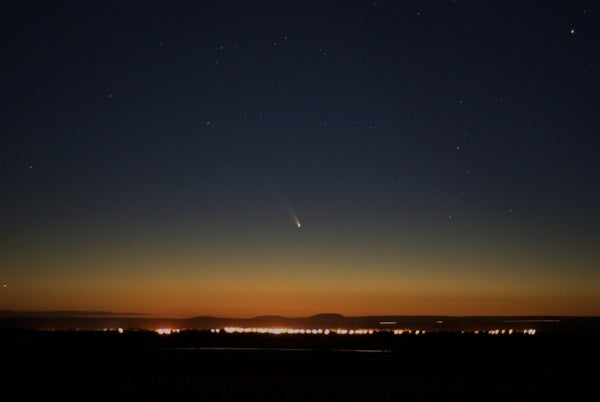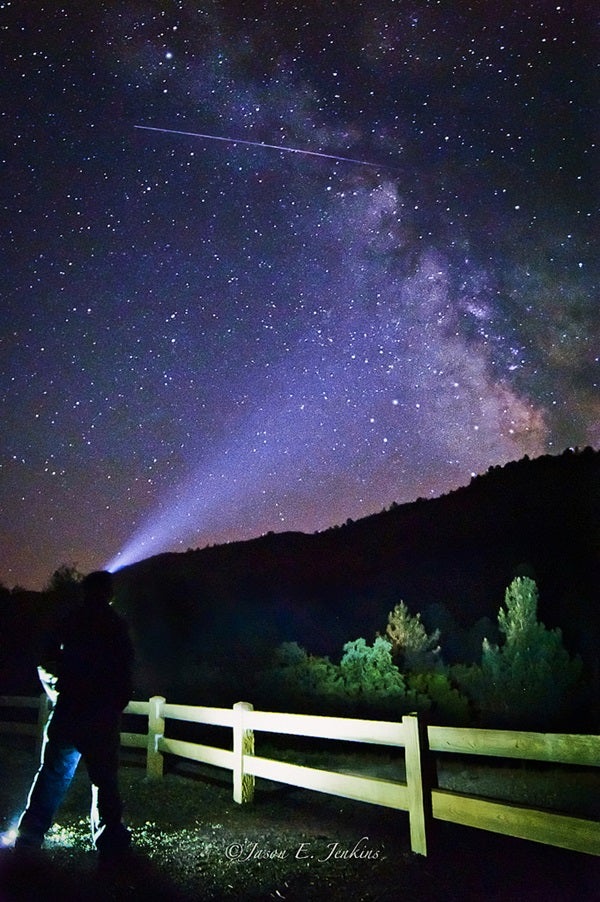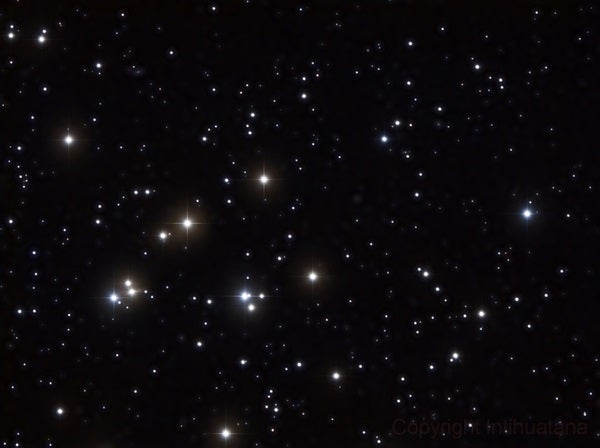Although the calendar says May, the sky’s Summer Triangle returns to prominence this month. The asterism’s three bright stars — Vega in Lyra, Deneb in Cygnus, and Altair in Aquila — all clear the horizon by midnight local daylight time. An hour later, they rule the eastern sky. Vega shines brightest and appears at the apex of the triangular asterism. Look for Deneb to Vega’s lower left and Altair to the lower right of the other two. The Summer Triangle will grace the Northern Hemisphere’s evening sky from now through the end of the year.
Saturday, May 5
The waning gibbous Moon appears roughly halfway between Mars and Saturn this morning. All three objects rise by 1:30 a.m. local daylight time and climb nearly 30° high in the south by 5 a.m. Mars shines at magnitude –0.5 and appears twice as bright as magnitude 0.3 Saturn. The trio stands against the backdrop of northern Sagittarius the Archer. If you view the Red Planet through a telescope, you’ll see its 12″-diameter disk and some subtle surface details. Meanwhile, the ringed planet shows an 18″-diameter disk surrounded by stunning rings that span 40″ and tilt 26° to our line of sight.
The Moon also reaches apogee today, at 8:35 p.m. EDT. It then lies 251,318 miles (404,457 kilometers) from Earth’s center, the farthest it gets from our planet during its month-long orbit.
The annual Eta Aquariid meteor shower peaks before dawn. Unfortunately, the waning gibbous Moon shares the sky, and its bright light will wash out fainter meteors and render the brighter ones less impressive. Don’t give up hope, however. For the best views, find an otherwise dark site and position yourself where a tree or building blocks the Moon’s direct light. The Eta Aquariid shower derives from bits of debris ejected by Comet 1P/Halley during its many trips around the Sun.
Although the Moon interferes with the Eta Aquariids, take a few minutes to enjoy a binocular view of our satellite next to Mars. The Moon slides 3° due north of the Red Planet at 3 a.m. EDT.
Monday, May 7
Last Quarter Moon occurs at 10:09 p.m. EDT. The half-lit orb doesn’t rise until around 2:30 a.m. local daylight time tomorrow morning, however, when you can see it climbing in the southeast among the background stars of eastern Capricornus.
Brilliant Jupiter reaches opposition and peak visibility tonight. It rises in the eastern sky at sunset and climbs highest in the south around 1 a.m. local daylight time. Shining at magnitude –2.5, the giant planet is the night’s brightest celestial object with the exception of the waning crescent Moon (which doesn’t rise until 3 a.m.) and Venus (which sets by 10:30 p.m.). Jupiter resides among the background stars of Libra, some 3° due east of 3rd-magnitude Zubenelgenubi (Alpha [α] Librae). When viewed through a telescope, the gas giant’s disk spans 45″ and shows incredible detail in its cloud tops. You’ll also see the planet’s four bright moons. Io, Europa, and Callisto line up in that order east of Jupiter while Ganymede is the lone moon west of the planet.

PlanetUser (Wikipedia)
Wednesday, May 9
You can use the Big Dipper as a guide to two of the spring sky’s brightest stars. If you follow the curve of the Dipper’s handle toward the eastern horizon, you’ll easily spot Arcturus. This magnitude 0.0 star, which belongs to Boötes the Herdsman, lies some 30° from the end of the Big Dipper’s handle. It is the fourth-brightest star in the whole sky and the second-brightest visible from mid-northern latitudes. And if you continue the curve another 30° past Arcturus, you’ll arrive at magnitude 1.0 Spica, the luminary of Virgo the Maiden. An easy way to remember the two is with the phrase: “Follow the arc to Arcturus, then drive a spike to Spica.”
Thursday, May 10
Dwarf planet 1 Ceres is the largest object in the asteroid belt, which lies between the orbits of Mars and Jupiter. It currently shines at magnitude 8.5 and is an easy object to spot through binoculars or a telescope. Ceres resides in northeastern Cancer the Crab, which appears high in the west after twilight fades to darkness. This evening, Ceres lies 2.4° west-northwest of 4th-magnitude Kappa (κ) Leonis.
One of the spring sky’s finest deep-sky objects, the Beehive star cluster (M44) in the constellation Cancer the Crab, lies high in the west once evening twilight fades away. The 3rd-magnitude cluster lies approximately 40 percent of the way from 1st-magnitude Pollux in Gemini to the similarly bright star Regulus in Leo. With naked eyes under a dark sky, you should be able to spot the Beehive as a faint cloud. But this star group explodes into dozens of stars through binoculars or a small telescope at low power.
Saturday, May 12
Although Comet PANSTARRS (C/2016 R2) glows faintly at 11th magnitude, this is a good evening to try to spot it against the backdrop of Auriga through an 8-inch or larger telescope. The comet resides exactly halfway between magnitude 0.1 Capella and magnitude 1.9 Beta (β) Aurigae. The comet should appear as a small fuzzball without much structure. Use fairly high power to get the best view.
Sunday, May 13
Brilliant Venus appears low in the west-northwest after sunset all week. Look for the blazing point of light starting a half-hour after sundown, when it stands 20° above the horizon. The planet shines at magnitude –3.9 and is by far the brightest object in the evening sky. As the sky darkens and the stars come out, you’ll see that Earth’s neighbor lies midway between Beta (β) and Zeta (ζ) Tauri, the horns of Taurus the Bull. If you point a telescope at Venus, the planet’s 12″-diameter disk appears 85 percent lit.












